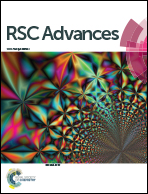5d, a novel analogue of 3-n-butylphthalide, protects brains against nervous injury induced by ischemia/reperfusion through Akt/Nrf2/NOX4 signaling pathway†
Abstract
Oxidative stress has been shown to play a vital role in the pathogenesis of the ischemia/reperfusion (I/R) and may represent a target for treatment. 3-Butyl-2-benzothiophen-1(3H)-one (5d), a novel analogue of the racemic 3-n-butylphthalide (NBP), exerts enhanced free radical scavenging, anti-platelet and anti-thrombotic effects, as well as preventive neuroprotection in a rat model of ischemia/reperfusion (I/R). Nevertheless, it is still unknown about the therapeutic effect of 5d against ischemic stroke and underlying mechanism(s) involved. 5d (30 mg kg−1 and 90 mg kg−1) significantly reduces brain damage after I/R in vivo, and protects primary cultured cortical neurons against oxygen-glucose deprivation and recovery (OGD/R)-induced cytotoxicity in vitro. Besides, 5d induces Nrf2 nuclear localization through PI3K/Akt signaling pathway, and lowers the intracellular ROS levels by lowering NADPH oxidase activity. However, Nrf2 siRNA transfection before OGD/R could decrease the neuronal cell viability and increase the expression of NOX4 elicited by 5d treatment. These results suggest that the therapeutic effect of 5d against ischemic stroke is due to the decrease of NADPH oxidase activity by promoting Nrf2 nuclear localization through PI3K/Akt signaling pathway. These findings point to that 5d might be an effective candidate for the treatment of ischemic stroke.


 Please wait while we load your content...
Please wait while we load your content...